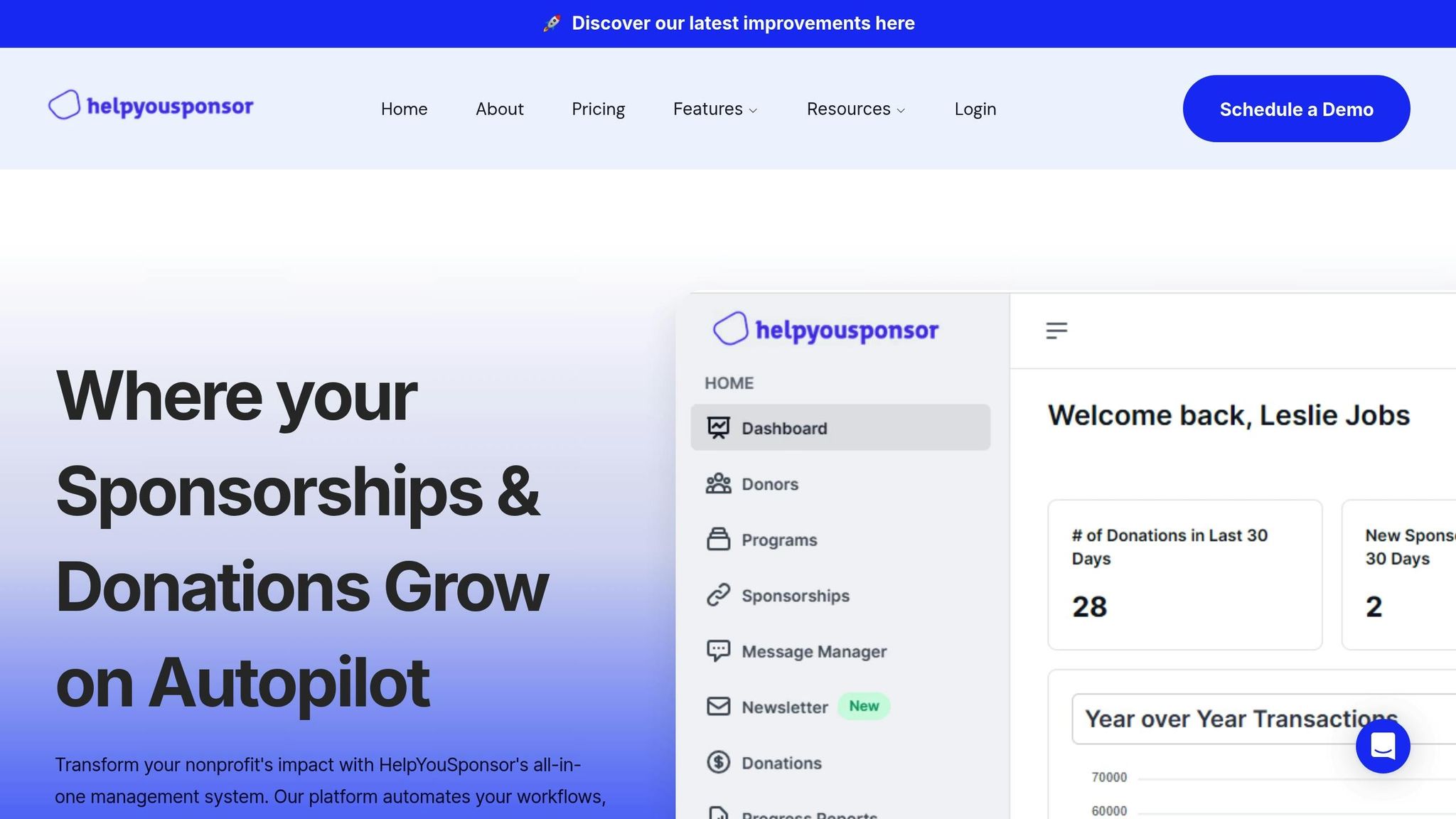Balancing Donor Privacy and Transparency
Nonprofits must navigate the challenge of protecting donor privacy while maintaining transparency to build trust and comply with legal requirements.

Nonprofits face a tough challenge: how to protect donor privacy while staying transparent enough to build trust and meet legal requirements. Donors want their personal data secure, but they also expect updates on how their contributions make an impact. At the same time, nonprofits must comply with public disclosure laws like filing Form 990 in the U.S., which adds another layer of complexity.
Key Takeaways:
- Privacy Matters: Donors trust nonprofits to safeguard their personal and financial information. Missteps like data breaches or sharing details without consent can harm relationships and lead to legal trouble.
- Transparency is Critical: Donors expect proof their contributions are making a difference. Nonprofits must show impact while adhering to privacy laws and respecting donor preferences.
- The Core Issue: Balancing privacy with transparency is tricky. Mismanagement can hurt trust, but getting it right strengthens donor relationships and retention.
Solutions include obtaining clear consent, using secure systems to protect data, and sharing aggregated impact reports to maintain transparency without exposing individual details. Tools like HelpYouSponsor simplify this process, offering privacy controls and easy reporting options.
Striking this balance isn’t just about compliance - it’s about building trust and ensuring long-term success.
How Do Nonprofits Protect Data Privacy For Fundraising? - The Nonprofit Digest
Legal Requirements for Donor Data
Nonprofits face the dual responsibility of protecting donor information while maintaining transparency. These legal obligations are crucial for addressing the challenges tied to donor data management.
US Data Protection Guidelines for Nonprofits
To uphold donor trust, nonprofits must prioritize secure data handling and clear communication. While specific legal requirements can differ depending on the region, adopting recognized data management practices is critical to ensure donor privacy remains intact.
Required Public Disclosures
Nonprofits are obligated to share essential financial and operational details to demonstrate accountability and maintain public trust.
New Developments and Evolving Regulations
With regulations constantly changing, nonprofits need to stay ahead by updating their data systems to align with new standards. Systems designed to adapt can help organizations meet these requirements while protecting donor privacy and ensuring transparency.
Common Problems Nonprofits Face
Nonprofits often face operational hurdles as they strive to balance privacy with transparency. These challenges go beyond legal compliance, directly impacting their day-to-day functioning and requiring careful planning and execution.
Managing Sensitive Donor Information
Protecting donor data is a critical concern for nonprofits. With the shift to digital systems, organizations must ensure secure cloud storage, seamless data transfers, and proper staff training to minimize errors. Any misstep can erode donor trust, making this an area that demands constant attention.
Third-Party Software Risks
Relying on external platforms, like CRMs, adds another layer of complexity. While these tools can streamline operations, they also introduce potential vulnerabilities. Nonprofits need to carefully vet vendors, regularly monitor their practices, and ensure their systems stay updated with robust security measures. Additionally, juggling the need for public acknowledgment of donors with the importance of maintaining donor anonymity can make data management even trickier.
Anonymous vs. Public Recognition
Finding the right balance between recognizing donors publicly and respecting their desire for privacy is an ongoing challenge. Donor retention is a high priority for many nonprofits, and public acknowledgment can play a role in fostering loyalty. However, some donors prefer to remain anonymous. To address this, nonprofits often use donor tier systems, but they must also create clear guidelines for disclosing contributions. Policies should be flexible enough to accommodate changes if donors later decide to adjust their privacy preferences.
Solutions for Privacy and Transparency
Nonprofits can strike a balance between safeguarding donor privacy and maintaining transparency by adopting thoughtful strategies that protect sensitive information while ensuring accountability. These approaches aim to build trust and foster long-term relationships with donors.
Getting Proper Consent from Donors
Start by using straightforward, easy-to-understand consent forms that clearly explain how donor information will be used, stored, and shared. These forms should address key areas such as communication preferences, options for public acknowledgment, and data retention policies.
Consider offering donors flexible privacy settings. For example, let them choose how they want to be recognized - whether that’s in annual reports, on social media, or not at all. This level of customization empowers donors to control their visibility.
Regularly updating consent agreements is equally important. Donors’ comfort levels may change over time, so providing an online portal or conducting annual updates can ensure their preferences stay current. Be sure to document all consent details, including dates and any changes, to safeguard both the organization and the donor in case of audits or inquiries.
Once consent is in place, the next step is securing donor data with robust protective measures.
Protecting Data with Security Measures
Limit the collection of donor data to only what’s absolutely necessary, and use modern cloud-based platforms with strong encryption and regular updates to store this information securely.
Enhance security by implementing role-based access controls, ensuring that only authorized personnel can access sensitive information. Regular staff training on safe digital practices is also essential to prevent accidental breaches or misuse.
Conduct regular audits to identify vulnerabilities and confirm that data protection protocols remain effective and up to date.
Reporting Without Compromising Privacy
With donor data securely managed, nonprofits can focus on transparent reporting that respects privacy. Use aggregated data to share results - such as total fundraising amounts, average donation sizes, or donor retention rates - without revealing individual donor details. This approach satisfies stakeholders’ need for accountability while protecting personal information.
To further enhance transparency, combine data-driven storytelling with donor recognition tiers like “Platinum Supporters.” This allows nonprofits to showcase program outcomes and donor contributions without exposing individual identities. Given that 62% of nonprofit leaders in 2025 identified donor retention as a top priority, highlighting measurable results can strengthen trust and foster meaningful connections.
For donors who prefer complete anonymity, offering anonymous reporting options ensures their privacy while still demonstrating overall funding sources and financial health to stakeholders. This balance of transparency and discretion helps nonprofits maintain credibility and build lasting donor relationships.
How HelpYouSponsor Helps with Compliance

Navigating the delicate balance between donor privacy and organizational transparency can be tricky. HelpYouSponsor steps in with tailored tools that help nonprofits safeguard donor information while meeting compliance standards and maintaining transparency.
Built-in Data Security
Protecting donor data is at the core of HelpYouSponsor. The platform incorporates advanced security measures that limit data access strictly to authorized personnel. This approach not only safeguards sensitive information but also reduces the burden on IT teams.
Flexible Privacy Controls
HelpYouSponsor provides nonprofits with customizable privacy settings, allowing them to decide how donor information is displayed and shared. Features like "Save Custom Views in the Donations" let organizations create and store tailored data configurations. This simplifies the process of generating reports that emphasize program outcomes and financial accountability while keeping individual donor details private.
Simple Reporting Tools
Creating compliance-friendly reports is effortless with HelpYouSponsor. The platform generates aggregated data summaries that meet transparency requirements without revealing sensitive donor details. Automated tools reduce the chance of errors, producing financial summaries and impact reports with ease. Additionally, an integrated messaging system ensures consistent, privacy-conscious communication with donors.
"Our latest updates are here to streamline your efforts and build lasting bonds with your donors."
Conclusion: Finding the Right Balance
In this article, we’ve delved into how clear consent, strong security measures, and open communication come together to create trust between nonprofits and their donors. Striking the right balance between respecting donor privacy and maintaining transparency isn't just about ticking compliance boxes - it's about fostering deeper, lasting connections with supporters. By implementing strategies like clear consent processes, secure data management practices, and well-defined privacy policies, nonprofits can safeguard donor information while meeting the expectations of their stakeholders.
Consider this: a recent study found that by 2025, 62% of nonprofit leaders identify donor retention as their top priority. This underscores just how critical trust and engagement are in today’s nonprofit landscape.
Technology is a key player in achieving this balance. Platforms like HelpYouSponsor offer customizable privacy settings and automated reporting tools, making it easier to stay compliant while improving efficiency. These tools allow nonprofits to focus more on their mission and build stronger relationships with their donors. They also highlight how technology bridges the gap between transparency and privacy.
Investing in the right systems and staff training doesn’t just simplify operations - it enhances donor relationships. When organizations treat privacy and transparency as complementary goals rather than competing ones, they can refine their practices to meet changing regulations and donor expectations head-on.
This commitment to protecting privacy while embracing openness lays the groundwork for long-term trust and success, ensuring nonprofits can continue to fulfill their mission effectively.
FAQs
How can nonprofits protect donor privacy while staying transparent and compliant with legal requirements?
Nonprofits can effectively manage the delicate balance between protecting donor privacy and maintaining transparency by adopting a few thoughtful strategies. First, comply with privacy regulations like GDPR or CCPA and clearly communicate to donors how their information will be used. Transparency doesn’t mean oversharing - it’s about being open while respecting boundaries.
For example, nonprofits can share financial reports, program updates, and success stories to showcase impact, all without revealing personal donor details. Additionally, using secure systems to store donor data and restricting access to only authorized staff ensures sensitive information stays protected. These measures not only fulfill legal and ethical responsibilities but also help foster trust and confidence among donors.
How can nonprofits respect donor privacy while recognizing their contributions, and what effect does this have on donor loyalty?
Nonprofits can respect donor privacy while still offering recognition by giving donors the choice to remain anonymous or decide how they’d like to be acknowledged. For instance, organizations might offer options like sending private thank-you notes, including names on donor walls, or listing contributions in annual reports without sharing personal details.
These approaches build trust and show that donor preferences are a priority. When donors feel their wishes are respected, they’re more likely to stay engaged and continue their support. Balancing privacy with transparency helps create a sense of security and appreciation, laying the groundwork for lasting relationships.
How can technology, like HelpYouSponsor, help nonprofits balance donor privacy with transparency?
Technology is crucial for nonprofits striving to balance donor privacy with operational transparency. Tools like HelpYouSponsor empower organizations to securely handle donor information, monitor fundraising efforts, and produce detailed, easy-to-understand reports for stakeholders.
HelpYouSponsor incorporates robust privacy measures to safeguard sensitive donor data while offering adjustable transparency options. This enables nonprofits to meet reporting obligations and strengthen trust with their supporters, all while ensuring donor confidentiality remains intact.

